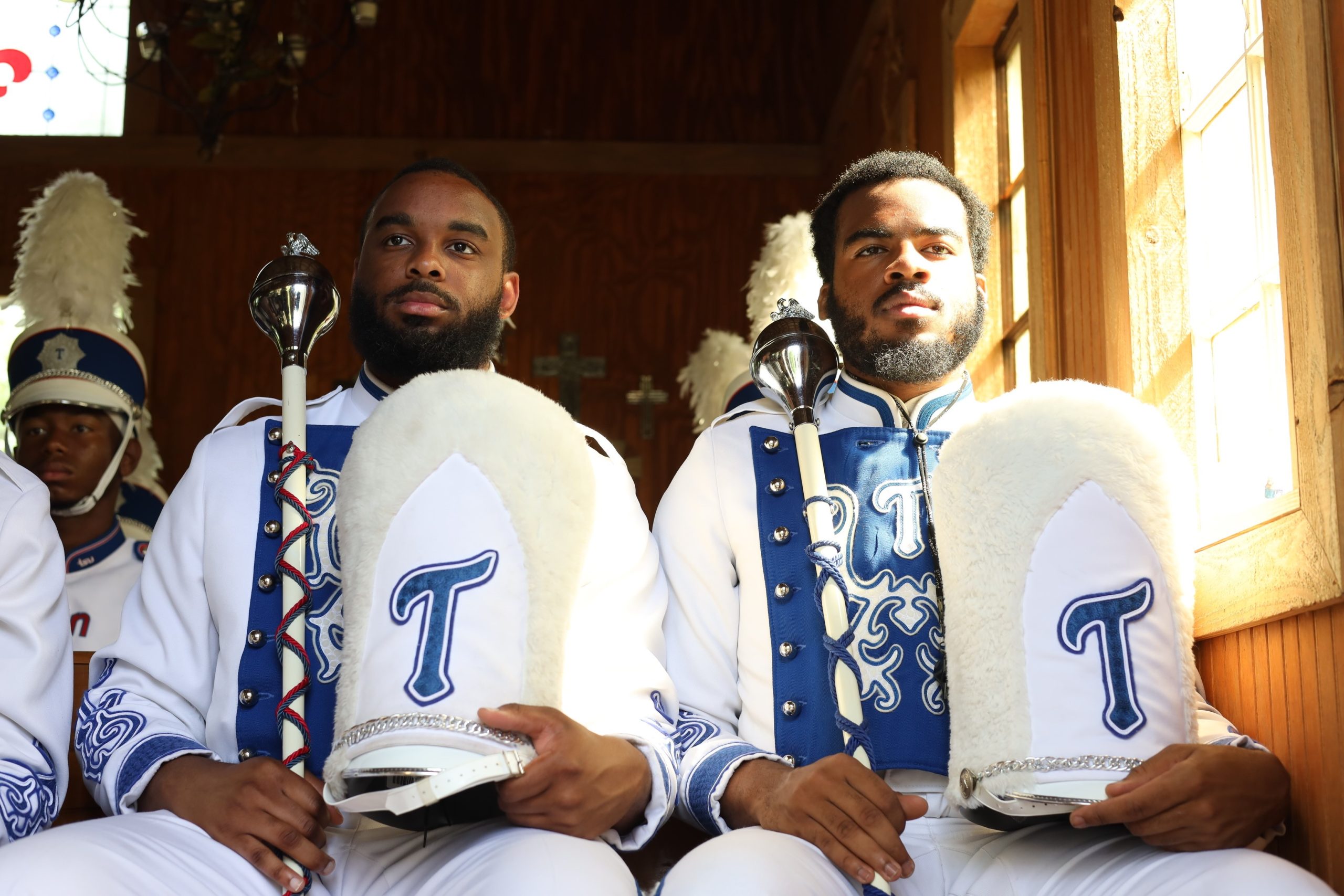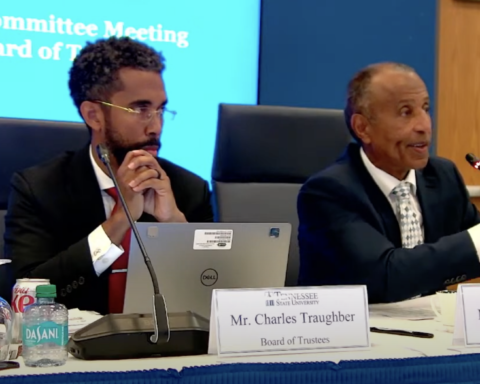By Jewly Hight
At the 2018 edition of Coachella, Beyoncé showed us how a global pop star celebrates the marching bands of historically Black colleges and universities in a spectacular festival performance, then translates that into a downright marvel of a concert documentary and live album.
Live performance is also the realm that the Aristocrat of Bands — pride of Nashville-based HBCU Tennessee State University — has excelled in for 76 years. The AOB’s reputation for precision and high-stepping showmanship on the field landed it on national television during a 1955 NFL game and brought an invitation to President Kennedy’s 1961 inauguration, both firsts for an HBCU band. In the last year, the AOB secured a coveted slot in the Rose Parade and an early July booking at Essence Fest alongside a couple of big gospel names, Jekalyn Carr and Sir The Baptist. That latter appearance served as a preview of a one-of-a-kind project, The Urban Hymnal, a studio album featuring the AOB as primary artist, fully in gospel mode for the first time, with an array of contemporary gospel stars in supporting roles.
Conceiving of the project took someone as connected in the industry as Sir The Baptist teaming up with someone as versed in the AOB’s sound, culture and operations as one of its assistant directors, Larry Jenkins. While Sir is a rapper, singer, songwriter and producer from Chicago, who has sauntered savvily, and with a strong sense of social purpose, between gospel, R&B and hip-hop since the mid-2010s, dropped tracks with Brandy and Killer Mike and picked up a Grammy nod for his work with Kierra Sheard, Jenkins is a virtuoso on trumpet and one of the AOB’s most skilled and imaginative composers and arrangers.
It was Sir who made the first move, expressing interest in the AOB and visiting Nashville to shadow the band on a game day. Jenkins, entrusted with running the school’s artist residency program, then asked Sir to sign on, and over a meal at a Mexican restaurant the two discussed what making an album during Sir’s artist residency could do for the students, filling at least one napkin with their ideas.
“We both wanted to see the kids win,” Sir recalls, seated next to Jenkins again, this time in TSU’s performance arts building. “We wanted to be a part of the kids’ story as they are creating their legacy, and really, really zone in on how to preserve the future for HBCU bands. But doing that, we needed to give ourselves a job as musicians, as creators.”
Sir and Jenkins would steer the students through the album-making process together, acting as co-producers on a few tracks, each taking on far more than the title usually implies before all was said and done.
In the AOB’s typical wide-ranging, crowd-pleasing, popular repertoire, the impact of gospel music is a bit more diffuse, present as an influence on the band’s secular selections, in the school song that shares its melody with the gospel chestnut “I’m So Glad” and via the backgrounds of students’ who’ve utilized their talents in church. The Urban Hymnal, which opens with a straightforward rendition of “I’m So Glad,” represents a fully realized union of towering, Black musical traditions.
“I think what makes it different, historic and important, is that it’s a marching band doing gospel,” says Sir. “And doing gospel roots can look spiritual, but also historic, because you’re picking up the legacy – the songs that carry your ancestors from cotton fields to where they are now.”
“I’ve worked with the Jay-Zs, the Beyoncés and all that sort of stuff,” he goes on, “but there’s no project I’ve worked on that has ever felt this legendary.”
It’s groundbreaking not only in concept, but execution: There really wasn’t an existing model for an album applying the meticulous layering, detailing and smoothing of a studio recording to a mighty marching unit like the AOB. (The soundtrack of the 2002 film Drumline, which featured bands or drum lines from a few different HBCUs on some of its tracks, is one of the closest analogues, and Sir learned all he could from its executive producer Dallas Austin, and paved the way for Austin’s involvement with the AOB as a fellow artist-in-residence.) As Sir The Baptist sagely observes, “It’s really hard to acoustically control a marching band. I mean, it’s just coming at you at once. They sound perfect the way they are, but that’s for live performance. As far as recording, it’s going to have to be a slow, meticulous walk.”
He helped transform the AOB’s on-campus rehearsal spaces — boxy, locker-lined band and percussion rooms — into makeshift studios. Jenkins was often the one conducting, as Sir glided down rows of chairs, being careful not to disturb the young musicians and their music stands, pausing to capture multiple takes from each instrument section with a single, high-quality microphone. To record the drum line, relying on the production expertise of hip-hop hitmaker and former TSU student Dubba-AA, Sir might position a mic underneath a drumhead to capture the attack of a stick or mallet, or move the drum across the room to get more spacious resonance.
The whole process was new to the students, Jenkins points out. He saw them “get to where they’re like, ‘Okay, we have to do this how many more times?’ You know, just learning what it’s like to be in a studio setting or to function as an artist. These are students who might be biology majors or might be majoring in education, anything outside of music. That was an interesting part of being in this band room and seeing their faces and watching them process. And then everything started to click with, ‘Oh, this is what it takes to get to where you want to go musically.’ ”
“We came to school to do what we’re used to doing — we still got that HBCU culture and we still got a marching band experience and a 50-yard-line halftime show,” reflects Curtis Olawumi, a trumpet-playing senior who became one of the AOB’s drum majors this year (and is, in fact, majoring in music). “I don’t recall anybody from any HBCU marching band doing this kind of stuff that we’re doing. Working on this project, the late nights and early mornings, it just feels so real.”
His contributions to the album include a dashing, jazzy trumpet solo during “Fly,” a sinuous track with a polyrhythmic, Afrobeat-style groove. “I never would have expected to be featured,” he says, with a sly grin. “I was just like, ‘You need this part played? I got you.’ You know, just being of service.”
Serial collaborator that he is, Sir called on his network — Kierra Sheard, Jekalyn Carr, Fred Hammond, Mali Music, J. Ivy, Dallas Austin, Donald Lawrence and others — to lend their voices to the project, speak with students and pitch in with promotion. “I’m holding everybody to a certain level of social responsibility,” he explains. “It’s our job to not just be great artists and businesspeople, but to also give to our community in a way that advances the next kid.”
He sent an engineer to record Sheard at home. The third-generation gospel luminary embraced the mission (she calls herself “a huge fan of HBCUs”) and agreed to sing on a triumphant new number called “Going Going,” which takes its refrain from a gospel hymn that originated with her heroes in the Hawkins Family. “I love that I’m a Black woman,” says Sheard. “I love where I come from. I love my culture. I love my history. I love how so many kings and queens have blazed the trail for me, whether it’s in education, business, my freedom. This song basically is monumental in gospel music. Tramaine Hawkins, the Hawkins, they are trailblazers for me. So it’s almost a way of paying tribute to them and what they’ve done.”
All of the material on The Urban Hymnal carries its historical consciousness proudly. Sir’s concise, contemporary writing, aided by Jenkins and others, builds up to a modern hymn refrain here or invokes an old spiritual there, and ranges not only across modern gospel’s many eras and sensibilities — Pentecostal praise breaks (“Dance Revival”), mass choirs (“Me Too”), sleek, R&B-tinged ballads (“Alright”, “Blessings on Blessings”), hip-hop hybrids (“Purpose”) — but its geographical landscape, from the American South to Great Migration destinations like Chicago and Detroit. Spiritual ecstasy, triumph and conviction abound, but so do softer searching and reassurance.
“It’s a journey of the gospel story, coming from 1619 all the way to 2022,” says Sir. “We have a lot of what gospel has arrived, to the Thomas Dorsey’s all the way to the Donald Lawrence’s to myself. We really took time to make this album a time capsule of gospel within advancement, of what the kids would like to dance to.” Sir doesn’t just mean in the church or the club–a dance team known as the Sophisticated Ladies is an eye-catching and indispensable part of all AOB performances.
Sir and Jenkins harnessed the students’ eager energy with expansive arrangements. There are moments, like a grand, live, 77-second rendition of “Jesus Loves Me,” when the AOB plays on its own, and additional passages where its members summon their potency to deliver lines at full blast, but those are outnumbered by the times that they fan out in bright, intricate patterns, filling spots traditionally devoted to gospel guitar and organ or providing clever counterpoint with grooves that are funky, buoyant or supple.
“In certain moments, I used them as an orchestra,” Sir explains. “I used them as a Motown band. I used them as a jazz band. They almost stepped into a different skin on every song.” And he improvised ways to preserve the distinctive character of the band’s sound, the jauntiness of the tubas, the resounding, regimented crack of the snare drums, the round rumble of polyrhythms played on big bass drums with fiberskyn heads, while also punching it up by layering on-off 808s and synthesizers. The hip-hop recording techniques he brought to the table, including riffs on producer tags — the robotic-sounding voice shouting out “Tymple,” Sir’s multimedia and ministry enterprise, and the “TSU!” chant where a crowd of voices lean on the “s” for nearly three beats, before hopping to the “u” like they’re executing a stylishly syncopated stutter step — ensure that one more tradition of Black musical innovation is felt on the album.
“The reason why that’s important,” Jenkins echoes, “is because marching band is not a monolithic thing. We hear ‘HBCU marching band,’ [and that] sometimes is presented as one thing … but there are levels to it. We get to showcase different elements of what we offer in our band. There are times when the woodwinds are getting more of the feature and you’re hearing the flutes and you’re hearing the clarinets do a part that you might not be able to hear if it’s 40 trumpets blaring. We’re making sure you catch all aspects that we have to offer musically.”
During the final track, “Alma Mater,” Jenkins intros the band’s director, Reginald McDonald, who delivers a congratulatory speech to the students under his leadership and runs down a list of historical accomplishments. Before it’s over, the voice of McDonald’s predecessor, Edward Graves, calls out from an old recording, “Who’s got the best band in the land?” The band members respond to the prompt the same way that they do every season: “TSU!”
“That’s how we always leave,” Jenkins affirms. “So hearing that just drives home the authenticity of what it is.”
Sir estimates that as many as a thousand people were involved in the making of the album. He looks at the whole herculean undertaking as an investment in the future; some of the proceeds will go to helping sustain the AOB program, and the template’s now out there for others to follow.
“A hundred years from now,” Sir muses, “hopefully there’s a kid in a band room with his friend working on music, and if they need a blueprint, we set it up to where they can say, ‘Okay, this is how you do it.’ “





